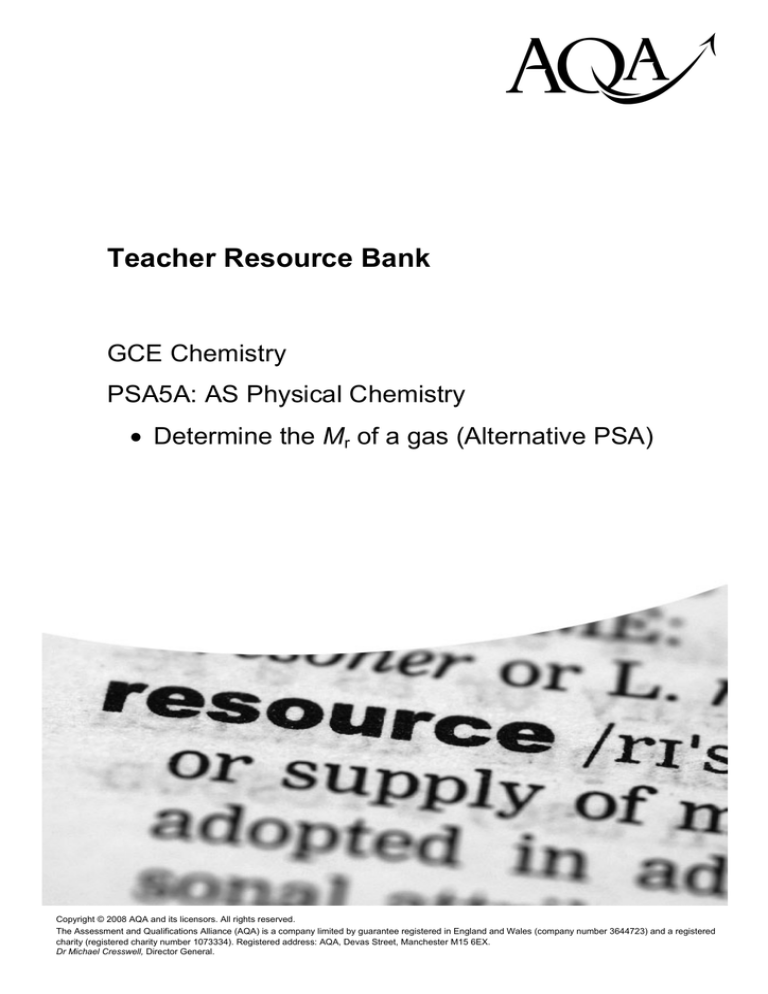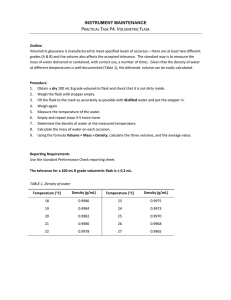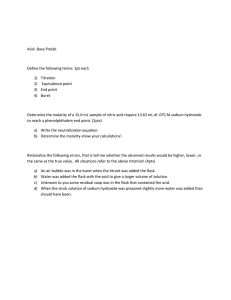
hij
Teacher Resource Bank
GCE Chemistry
PSA5A: AS Physical Chemistry
• Determine the Mr of a gas (Alternative PSA)
Copyright © 2008 AQA and its licensors. All rights reserved.
The Assessment and Qualifications Alliance (AQA) is a company limited by guarantee registered in England and Wales (company number 3644723) and a registered
charity (registered charity number 1073334). Registered address: AQA, Devas Street, Manchester M15 6EX.
Dr Michael Cresswell, Director General.
AS Physical Chemistry
PSA5A
Determine the Mr of a gas (Alternative PSA)
TECHNICAL SHEET
To determine the Mr of a gas
Whenever possible, students should work individually.
If it is essential to work in a pair or in a small group, because of the availability of
apparatus, supervisors must be satisfied that they are able to assess the contribution
from each student to the practical activity.
Requirements
•
•
•
•
volumetric (graduated flask) (250 cm3)
butane or dry CO2
thermometer (- 10 oC to 110 oC)
balance (preferably to a precision of at least 2 d.p.)
Centres are expected to carry out and be responsible for their
own safety risk assessments.
klm
Copyright © 2008 AQA and its licensors. All rights reserved.
1
AS Physical Chemistry
PSA5A
Determine the Mr of a gas (Alternative PSA)
Student Sheet
It is the responsibility of the student to carry out and be responsible for
their own safety risk assessment before carrying out this experiment.
Wear safety glasses at all times. Assume that all of the reagents and
liquids are toxic, corrosive and flammable.
The relative molecular mass of a gas can be determined by measuring the mass of a
known volume of the gas under known conditions of temperature and pressure.
Experiment
a) Using a balance which is precise to at least two decimal places, weigh
a dry 250 cm3 volumetric flask full of air. Record its mass.
b) Working in a fume cupboard, pass the gas provided into the
volumetric flask for three minutes.
c) Stopper the volumetric flask and reweigh it full of gas.
d) Pass the gas into the volumetric flask again for two or three minutes
and then reweigh the flask. This is to check that all of the air has been
displaced.
e) Record the mass of the flask and also make a note of the
temperature.
f) Completely fill the volumetric flask with water up to the level of the
stopper. Dry the outside of the flask if necessary and reweigh the
stoppered volumetric flask full of water.
g) Make certain that you produce a clear and organised set of results,
before proceeding to the next stage. Give due regard to units and to
the precision of the readings.
h) Calculate the Mr of gas by following the method outlined below.
Analysing the data
You should be familiar with the ideal gas equation
pV = nRT
•
•
Calculate the volume of the volumetric flask in cm3 by subtracting the mass of
the flask + air from the mass of the flask + water and assuming that the
density of water is exactly 1.00 g cm-3
(N.B we are ignoring the small mass of air in the flask in this calculation,
because it is insignificant relative to the mass of water)
Calculate the mass of air in the flask by assuming that 1 dm3 of dry air has a
mass of 1.205 g at the temperature of your experiment. [This is not an exact
value]
AS Physical Chemistry
PSA5A
•
•
•
•
•
•
Determine the Mr of a gas (Alternative PSA)
Calculate the mass of the flask by subtracting the mass of air from the total
mass of the flask + air.
Calculate the mass of gas (m) in the flask by subtracting the mass of the flask
from the mass of the flask + gas.
Measure atmospheric pressure if you are able, but otherwise, assume that
atmospheric pressure is 100 kPa
Convert the temperature to Kelvins by calculating T = (T oC + 273) K
The gas constant, R = 8.31 J K-1 mol-1
Convert the volume of gas to m3 by calculating (cm3 x 10-6)
Use these data to calculate the number of moles of gas as follows
We know that
pV = nRT
and the number of moles is given by
n = m/Mr
Therefore
pV = mRT/Mr
When this relationship is rearranged, it can be used to calculate the relative
molecular mass of the volatile liquid.
Mr = mRT/pV
AS Physical Chemistry
PSA5A
Determine the Mr of a gas (Alternative PSA)
TEACHER NOTES AND MARKING GUIDANCE
The specific marking guidance in the specification is as follows
2 marks: All areas of the task are carried out competently.
The apparatus is weighed precisely and handled carefully.
The transfer of liquid or gas is carried out safely and with due care.
The apparatus is equilibrated and all necessary measurements taken.
1 mark: One of the areas of the task is performed poorly.
The apparatus is weighed imprecisely or handled without due care OR
The transfer of liquid or gas is not carried out safely or with due care OR
The apparatus has not equilibrated or some measurements are not taken.
0 marks: At least two of the areas of the task are performed poorly.
The apparatus is weighed imprecisely or handled without due care.
The transfer of liquid or gas is not carried out safely or with due care.
The apparatus has not equilibrated or some measurements are not taken.
Guidance for Teachers and Students
Teachers are expected to exercise professional judgement in assessing the
competence of their candidates in following the instructions.
Candidates should have been given guidance in the correct use of equipment and
this guidance can continue during the practical session for which this PSA forms
a part.
If, however, the guidance required is fundamental or frequent, then the student
should not be awarded 2 marks.
Judgement of 2 marks, 1 mark or 0 marks will depend on whether the candidate has
carried out the activity with care.
Students should not be judged on their ability to apply the ideal gas equation nor on
their ability to calculate values for the relative molecular mass of carbon dioxide.
They should be judged on their ability to follow the instructions and to carry out the
practical task which leads to the production of a valid set of results. It is unlikely that
the results are very reliable but this provides a useful opportunity to discuss the
limitations in the technique and how it might be improved.
It is important to remember when marking these practical exercises that PSA is about
student competence and that for a student to score full marks on this exercise
perfection is neither expected nor required.
4
Copyright © 2008 AQA and its licensors. All rights reserved.
klm






